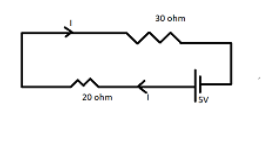
Answer
376.5k+ views
Hint: In diode circuit system, the current will be passed through forward biased diode and the current will not be passed through the reverse biased diode. So, using this concept we will solve this problem.
Complete answer:
The current will be passed through forward biased diodes and current will not flow from reverse biased diodes. The equivalent circuit as follow:

In this circuit we can see that the reverse diode is removed or neglected in the above circuit as no current is being passed in this circuit.
To obtain the current we need to find total (equivalent) resistance, ${R_{eq}} = $Sum of all resistances in the circuits.
$ {R_{eq}} = 20\Omega + 30\Omega \\
{R_{eq}} = 50\Omega \\ $
Potential difference, $V = 5V$
Potential difference, $V = I{R_{eq}}$
$I = \dfrac{V}{{{R_{eq}}}}$
All data required in this formula is provided above. So, substituting these values in the above formula we get:
$ I = \dfrac{5}{{50}}A \\
I = \dfrac{1}{{10}}A \\ $
The current in the above circuit is $\dfrac{1}{{10}}A$.
Note: We saw that a forward biased diode allows current to flow while reverse diode doesn’t but there is a kind of diode which allows current to flow either in forward direction or in reverse direction. This diode is known as Zener diode. This diode is especially designed to pass the current in the reverse direction when certain voltage is reached. It is a highly doped p-n junction.
Uses of Zener diode:
For voltage regulation
As switch
Clippers circuit
Surge suppressors
Complete answer:
The current will be passed through forward biased diodes and current will not flow from reverse biased diodes. The equivalent circuit as follow:

In this circuit we can see that the reverse diode is removed or neglected in the above circuit as no current is being passed in this circuit.
To obtain the current we need to find total (equivalent) resistance, ${R_{eq}} = $Sum of all resistances in the circuits.
$ {R_{eq}} = 20\Omega + 30\Omega \\
{R_{eq}} = 50\Omega \\ $
Potential difference, $V = 5V$
Potential difference, $V = I{R_{eq}}$
$I = \dfrac{V}{{{R_{eq}}}}$
All data required in this formula is provided above. So, substituting these values in the above formula we get:
$ I = \dfrac{5}{{50}}A \\
I = \dfrac{1}{{10}}A \\ $
The current in the above circuit is $\dfrac{1}{{10}}A$.
Note: We saw that a forward biased diode allows current to flow while reverse diode doesn’t but there is a kind of diode which allows current to flow either in forward direction or in reverse direction. This diode is known as Zener diode. This diode is especially designed to pass the current in the reverse direction when certain voltage is reached. It is a highly doped p-n junction.
Uses of Zener diode:
For voltage regulation
As switch
Clippers circuit
Surge suppressors
Recently Updated Pages
How many sigma and pi bonds are present in HCequiv class 11 chemistry CBSE

Mark and label the given geoinformation on the outline class 11 social science CBSE

When people say No pun intended what does that mea class 8 english CBSE

Name the states which share their boundary with Indias class 9 social science CBSE

Give an account of the Northern Plains of India class 9 social science CBSE

Change the following sentences into negative and interrogative class 10 english CBSE

Trending doubts
Fill the blanks with the suitable prepositions 1 The class 9 english CBSE

The Equation xxx + 2 is Satisfied when x is Equal to Class 10 Maths

In Indian rupees 1 trillion is equal to how many c class 8 maths CBSE

Which are the Top 10 Largest Countries of the World?

How do you graph the function fx 4x class 9 maths CBSE

Give 10 examples for herbs , shrubs , climbers , creepers

Difference Between Plant Cell and Animal Cell

Difference between Prokaryotic cell and Eukaryotic class 11 biology CBSE

Why is there a time difference of about 5 hours between class 10 social science CBSE




